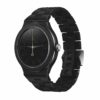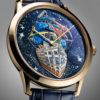Episode 2: The secrets of the Chronomètre à Résonance
In a long interview, the master watchmaker confided in us about the origins of four founding timepieces of his brand: the Tourbillon Souverain (1999-2003), the Chronomètre à Résonance (2000-2004), the Sonnerie Souveraine (2006-2019) and the Astronomic Souveraine (2020). In a series of four chapters, he explains the genesis of these four models, their raison d’être, but he also reveals his creative process, the work in progress and his ultimate quest. Isabelle Cerboneschi

In 1999 François Paul Journe presented two watches in Basel: a tourbillon chronometer with a remontoir d’égalité and a resonance chronometer with a double movement, in order to achieve unequalled precision. “When worn, it loses less than a second a week,” said François-Paul Journe.
Something magical happens when two balances resonate. And yet magic has nothing to do with this process, which is based on physics: every object emits and receives a vibration. When two moving pendulums are placed together, one adopts the rhythm of the other. They resonate, harmonise and balance each other. The result is synchronised oscillation, which leads to better performance. The first physically visible research on this phenomenon was carried out by Antide Janvier (1751-1835) and Abraham-Louis Breguet in the 18th century.
In the autumn of 2001, François-Paul Journe acquired one of Antide Janvier’s three resonance regulators at an auction conducted by Antiquorum, for the sum of CHF 1,488,500. The second was bought by the Patek Philippe Museum and the third is the property of the Paul-Dupuy Museum in Toulouse.
INTERVIEW
Can you explain in your own way this physical phenomenon of resonance, which, for a neophyte, is like magic?
François-Paul Journe : It took me a long time to find a way to explain it: when I speak to you, your ear is in resonance with my voice, which is a vibration. When you listen to a watch, you hear it ticking. The ticking is the dispersed energy of the watch that vibrates the eardrum and escapes as noise. In the chronometer, it’s the same thing: the two balances are in resonance because they are set to the same frequency. They absorb the energy of one and the other and resonate naturally, but in order to do this, all the components of the escapement must be perfectly finished, otherwise it doesn’t work.
How do you explain the fact that since Abraham-Louis Breguet, so few watchmakers have been interested in this phenomenon?
It was Christian Huygens (1629-1695) who first noticed this phenomenon and explained it, but there is no trace of an object he had made. The first watchmaker known to have made a resonance regulator was Antide Janvier, in 1780. He was brilliant but not a very good manager. After the French Revolution, he fell into disgrace and sold part of his workshop to Abraham-Louis Breguet, who helped him a lot. Breguet, who had seen his work, began working on resonance around 1810-1815, 30 years later than Janvier. He made three pocket watches and two resonance regulators, one of which was for King George IV of England and is kept at Buckingham Palace, and the other created for Louis XVIII. This one is at the Art et Métiers. It was while revising it that I was fascinated by the phenomenon of resonance, in the 1980s. At the time, it was at a standstill and was called a “double regulator”. We thought it was pretty but we didn’t know what it was for. When I had it serviced, I understood the system and became interested in it. The first order I received from a Parisian client in 1982 was for a resonance pocket watch. I made it but I was not sufficiently skilled to make it complete: it resonated a little, but not enough. I told myself that one day I would take up this project again. The trigger was in 1996 when Philippe Dufour brought out his Duality, which included a double regulator. It wasn’t a resonance but it reminded me that I had this job to do and that’s when I started to design the watch.
How would you describe it?
In 2002, George Daniels came here to the factory. He asked to see my Resonance Chronometer and he said, “You had a lot of courage to do that. I think that’s what best describes this watch: courage. He wanted to buy me one. I suggested that we exchange watches. I would have liked the one he was making at the time: he had made a series of 50 automatic calendar watches with a coaxial escapement. We hung out together, and in 2003 I suggested that we meet, but he replied that he was no longer working and the exchange never took place.

Your first resonance watch of 1999 had two springs. In the latest model launched 20 years later, you have kept only one mainspring for both movements. Why did you do this?
I wanted to improve the watch. Thanks to a differential placed on the first wheel visible in the centre of the dial, the force of the mainspring is transmitted independently to the two secondary gears, each of which is equipped with an equal winding mechanism. As a result, the force received at the escapements is linear and isochronism is assured for 28 hours. I wanted to add a special escapement, which is currently under development, but fortunately I didn’t because the watch wouldn’t have been released (laughs)! When everything is new in a movement, it’s like trying to jump an obstacle with sand under your feet. In order to jump, you need a lead foot. By using the same escapement as the first resonance watch, I had my take-off foot: I know it, it works very well, so I wasn’t taking too many risks.
Do you intend to launch this new special escapement soon?
If it works, yes, if it doesn’t, no (laughs). I am testing it with a Chronomètre Souverain. If it works, it will be used in all the watches. It is too beautiful!
What is its principle?
It is a free escapement, like a trigger, but without a spring. The detent escapements found in marine chronometers, without oil, with direct impulse, are great, but you need a lot of force to make them work. I made a lot of them: my first pocket tourbillons are all with detent escapements. But it works less well on a wristwatch. Watchmaking has to work with very little energy and the most creative solution, which works without oil and with little energy, is the Atmos clock invented by Jean-Léon Reutter. When there is almost no friction, there is no need for lubrication. When you make watches, you have to go in that direction.

















